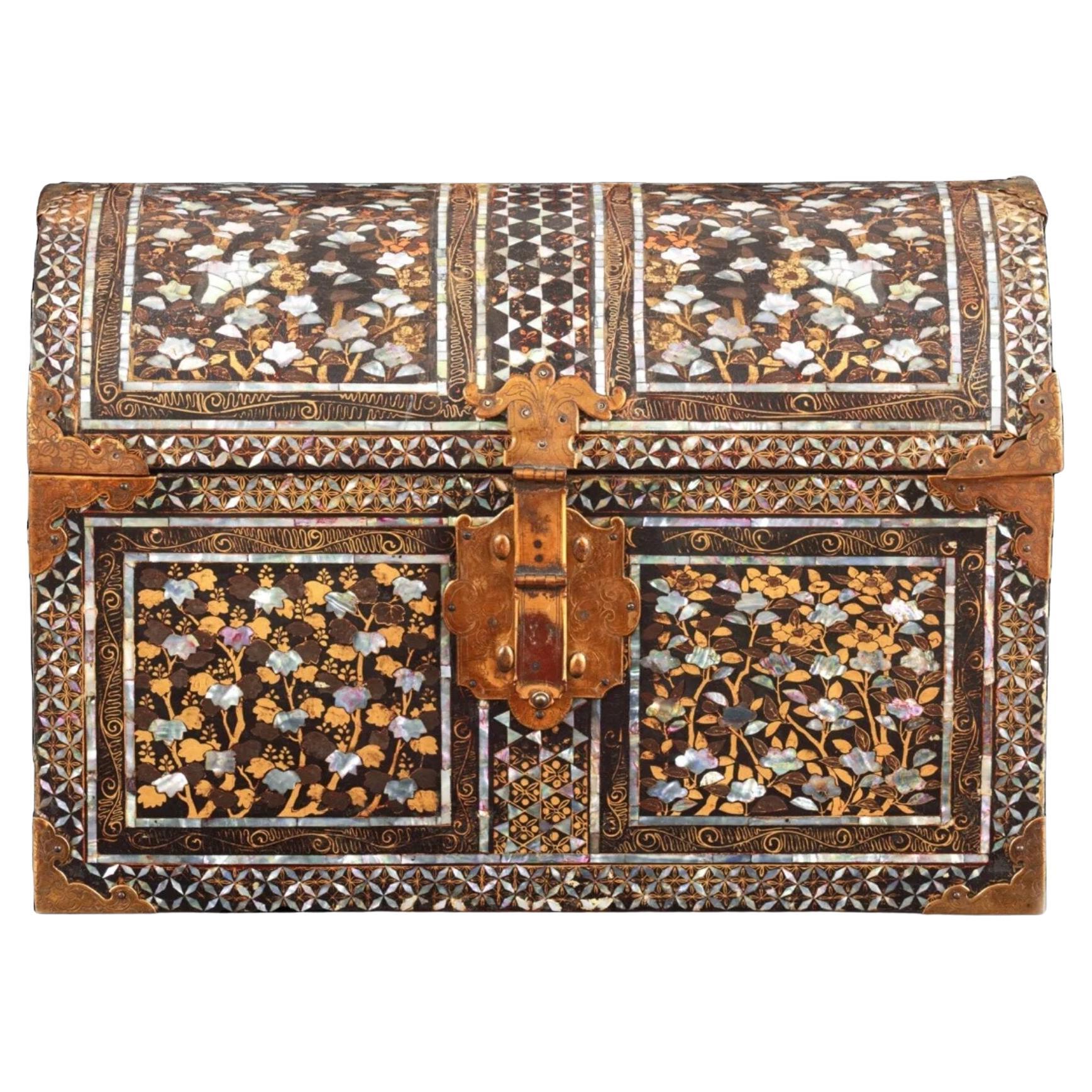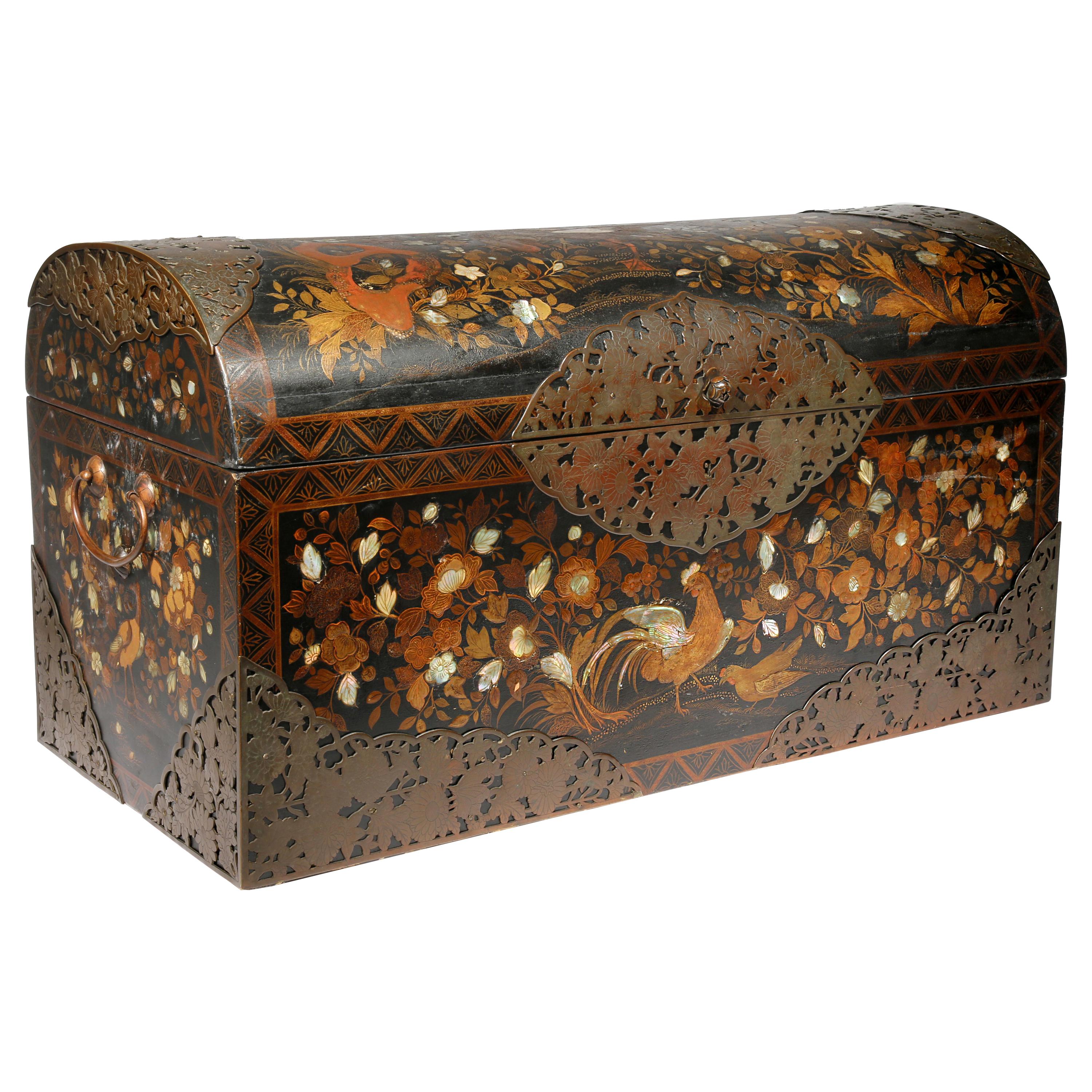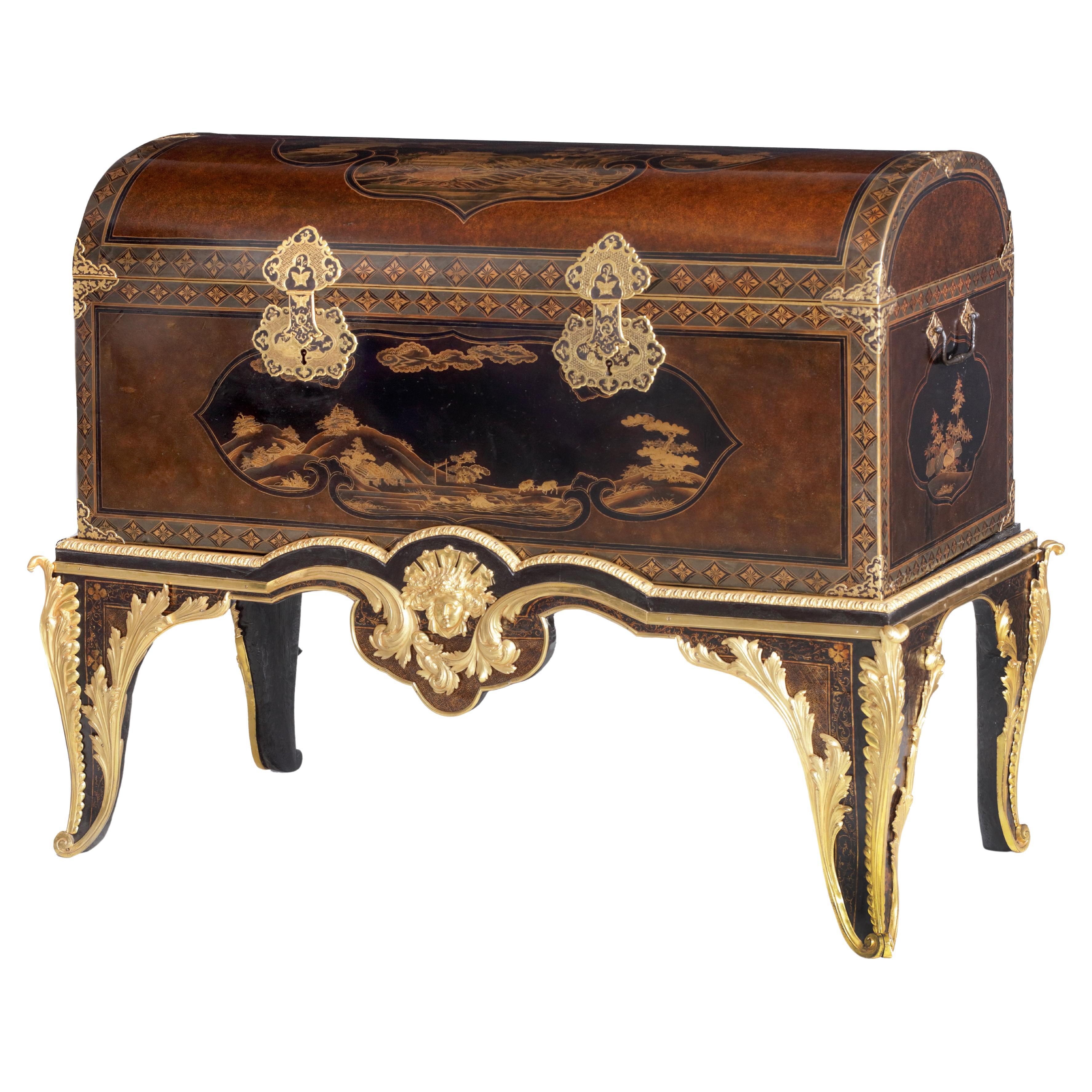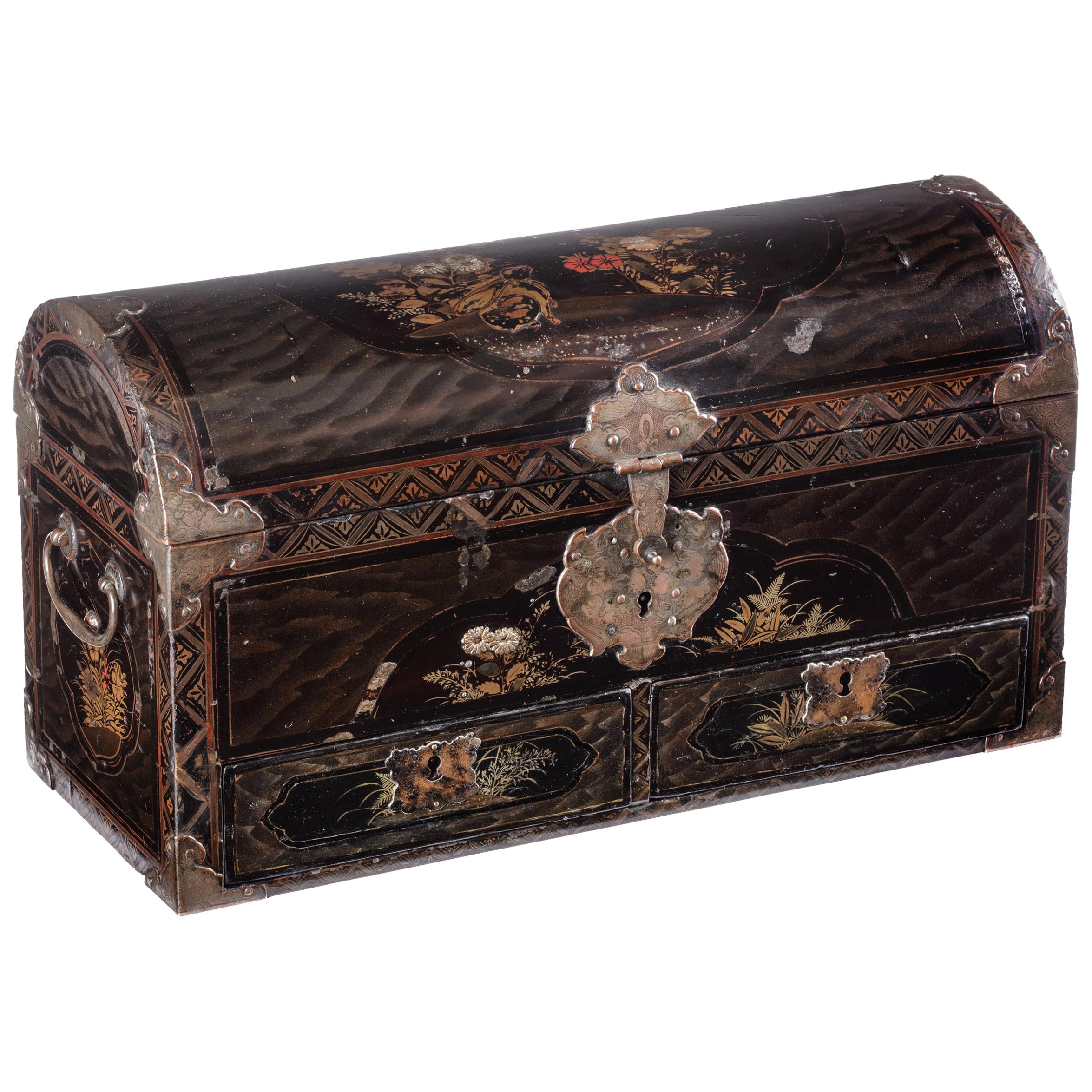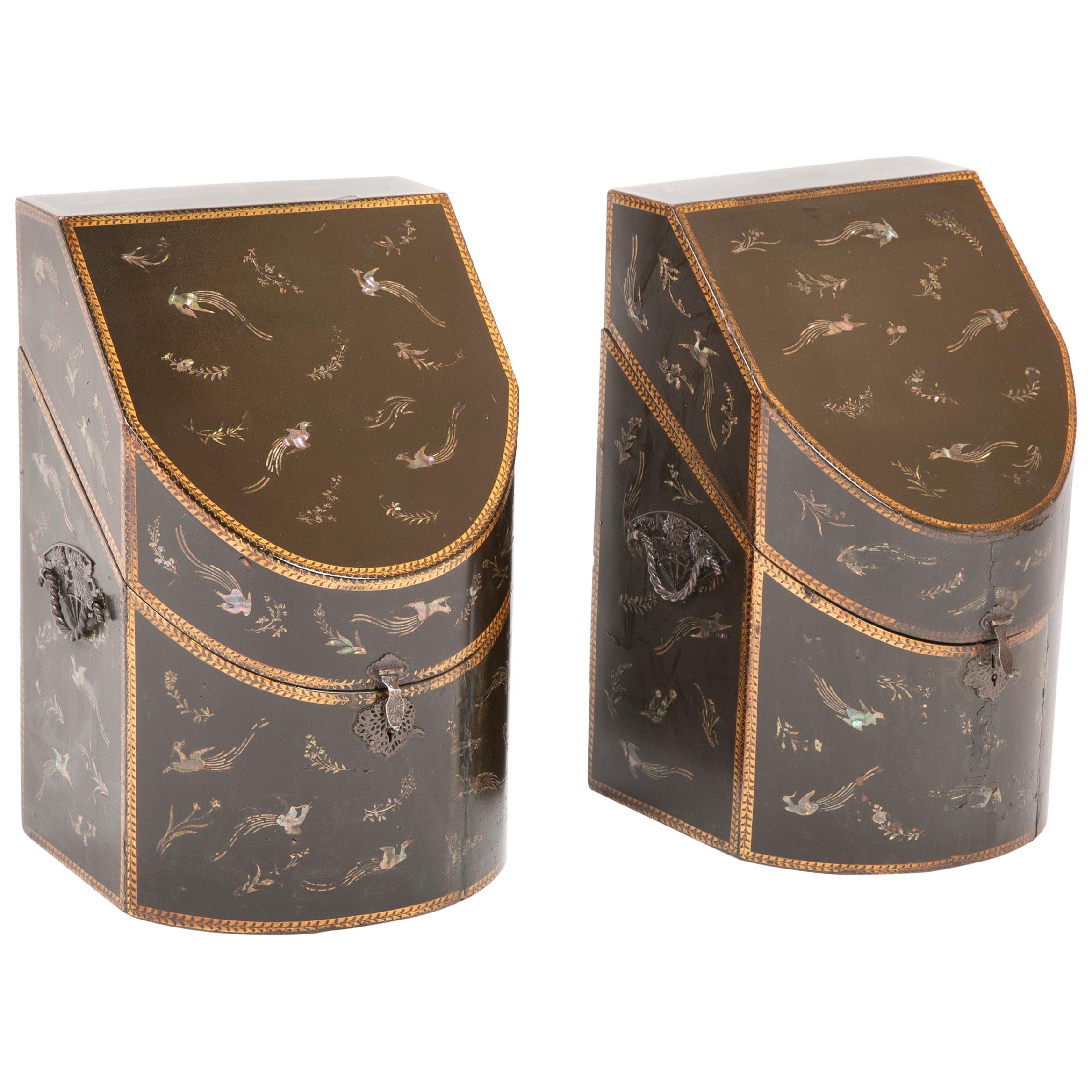Items Similar to A rare Japanese Namban export lacquer coffer with Mon emblems
Want more images or videos?
Request additional images or videos from the seller
1 of 20
A rare Japanese Namban export lacquer coffer with Mon emblems
About the Item
Late Momoyama period, late 16th century
The coffer is decorated in black lacquer, urushi, on cedar wood, decorated with gold dust and silver, maki-e, and nashiji, mother-of-pearl, raden, and red copper mounts in the Kõdaiji-style.
H. 29.2 x W. 45 x D. 38.5 cm
Provenance:
Private collection, the Netherlands
Private collection, Switzerland
Although the form of the box is European/ Iberian, the decoration with several mon that each identify a Japanese family, clan, or individual indicates that this box was probably intended for the Japanese domestic market and not the export market. Mon can be regarded more or less as the Japanese equivalent of the coat-of-arms in European society. The mon possibly originated over a thousand years ago from banners used by warriors on the battlefield in order to distinguish each other. There are 241 different kinds of mon known, but today, with all their variations, about 20.000 exist. In the Edo period, samurai used them to identify themselves, but some particular mon have always been reserved for the Imperial Court.
The mon on the present chest include; Katabami (oxalis), Goshichi-no-kiri (paulownia), Sakura (cherry blossom), Yuroku- kiku (16 petals of chrysanthemum) and Shyppo (the 7 treasures). So most mon consist of stylised flowers.
This coffer was made in the late Momoyama period, the time when Hideyoshi (1537-1598) reigned Japan. He was of peasant ancestry but, nevertheless, became a very powerful general, bringing the ‘Warring States period’ to an
end and unifying Japan. He is also known for crucifying the ‘Twenty-six Martyrs of Japan’ in 1597 to set an example for the Japanese who wanted to convert to Christianity.
- Dimensions:Height: 11.03 in (28 cm)Width: 17.72 in (45 cm)Depth: 15.16 in (38.5 cm)
- Materials and Techniques:
- Place of Origin:
- Period:
- Date of Manufacture:Late 16th century
- Condition:Repaired: Some damages relacquered. Wear consistent with age and use.
- Seller Location:Amsterdam, NL
- Reference Number:1stDibs: LU5458239041132
About the Seller
5.0
Vetted Seller
These experienced sellers undergo a comprehensive evaluation by our team of in-house experts.
Established in 1985
1stDibs seller since 2020
19 sales on 1stDibs
Typical response time: 3 hours
- ShippingRetrieving quote...Ships From: Amsterdam, Netherlands
- Return PolicyA return for this item may be initiated within 7 days of delivery.
More From This SellerView All
- Superb Late 16th Century Signed Colonial Japanese Namban Export Lacquer CofferLocated in Amsterdam, NLSuperb late 16th century signed colonial Japanese Namban export lacquer coffer Momoyama period, late 16th/early 17th century, inscribed 'Arisato' on the bottom H. 30.5 x W. 43...Category
Antique 16th Century Japanese Lacquer
MaterialsCedar, Lacquer
- Large Japanese Namban Lacquer Coffer Arqueta, 16th CenturyLocated in Amsterdam, NLA large Japanese Namban lacquer arqueta coffer for the Portuguese market Kyoto, Momoyama-period, late 16th century In Hinoki cypress lacquered in ...Category
Antique 16th Century Japanese Decorative Boxes
MaterialsMother-of-Pearl, Wood
- 17th-Century Japanese Namban Lacquer Coffer on French Stand, Possibly by BoulleBy André-Charles BoulleLocated in Amsterdam, NLAn impressive and large Japanese 'Namban' transition-style lacquer coffer with fine gilt copper mounts on a French Re´gence base, possibly by André-Charles Boulle (1642-1732) Kyot...Category
Antique 17th Century Japanese Lacquer
MaterialsBrass, Ormolu
- Fine Japanese Namban Lacquer Jewelry Casket, 17th CenturyLocated in Amsterdam, NLJapanese Namban lacquer transition-style coffer with two drawers Kyoto/Nagasaki, circa 1650 The cartouches with gilt and red decorations of leaves...Category
Antique 17th Century Japanese Edo Lacquer
MaterialsCypress
- Rare 17th Century Japanese Export Lacquer Medical Instrument BoxLocated in Amsterdam, NLA rare Japanese export lacquer medical instrument box Edo-period, 1650-1700 L. 19 x W. 6 x H. 8.5 cm This unconventionally shaped lacquer b...Category
Antique 17th Century Japanese Edo Lacquer
MaterialsGold
- Unique 17th Century Miniature Japanese Namban Lacquer Miniature Dollhouse ChestLocated in Amsterdam, NLA unique and exceptional Japanese miniature or dollhouse export lacquered chest Kyoto, circa 1620-1640 The chest of rectangular shape with a domed lid, decorated in Transition-style, in gold hiramaki-e on a black background within reserved lobed cartouches decorated with landscapes animated with birds and rabbits, on a shagreen or samegawa background. The borders are decorated with geometric friezes, the box with gilt-copper mounts, the interior decorated in red lacquer. Measures: H 9.2 x W 14.5 x D 7.2 cm This miniature is of exceptional quality and a perfect copy of the famous large size Transition-style coffers. It was most likely ordered by a Dutch lady for her dollhouse (poppenhuis), like the famous Petronella Oortman (1656-1716) doll-house, which is now one of the highlights in the collection of the Rijksmuseum Amsterdam, or Petronella Oortmans-de la Court’s (1624-1707) dollhouse in the collection of the Centraal Museum Utrecht. Sara Rothé of Amsterdam in 1743 ordered a miniature black lacquered ivory tripod table with gold chinoiserie decoration by Jurriaan Buttner (Monika Kopplin, European Lacquer, 2010, p. 56). Other Japanned dollhouse...Category
Antique 17th Century Japanese Edo Lacquer
MaterialsShagreen, Cypress
You May Also Like
- Japanese Namban Lacquer and Inlay Coffer Momoyama PeriodLocated in Atlanta, GAA rare Japanese Namban Lacquer domed coffer circa 1570-1610s of Azuchi-Momoyama to early Edo period. These types of lacquerware were made for export to ...Category
Antique 16th Century Japanese Japonisme Lacquer
MaterialsWood, Lacquer
- Rare pair of Japanese Nagasaki Export Lacquered Wood Knife BoxesLocated in Stamford, CTRare pair of Japanese Nagasaki Export lacquered wood knife boxes with mother-of-pearl inlay of flowers and birds, now converted to letter boxes. The boxes were converted to letter b...Category
Antique Early 19th Century Japanese Anglo-Japanese Knife Boxes
MaterialsWood
- Antique Japanese Export Lacquer Bamboo Stick StandLocated in Brea, CAAntique Japanese export lacquer and gilt bamboo stick stand, see more pictures, 46'' x 27.5'' x 10''.Category
Early 20th Century Japanese Meiji Lacquer
MaterialsBamboo
- Japanese Lacquer Tray With CardsLocated in New Orleans, LAThis Meiji-period lacquer tray represents the mastery of Japanese craftsmen in the art of lacquer work. Precious materials are precisely inlaid in the lacquer base, creating a highly...Category
Antique Late 19th Century Japanese Meiji Lacquer
MaterialsGold
- Rare Japanese Lacquer Writing Box Suzuribako Meiji PeriodLocated in Atlanta, GAA Japanese Lacquer writing box Suzuribako Meiji Period (1868-1912), likely circa late 19th century. This suzuribako is one of the most unusual boxe...Category
Antique 19th Century Japanese Japonisme Lacquer
MaterialsLacquer
- 19th Century, Japanese Export Lacquer Tray Maki-e & Mnt Fuji Pagoda DecorationLocated in Atlanta, GAJapanese, 19th century. A very fine quality Japanese lacquer tray. The tray is heavily decorated with a traditional Maki-e gold, black & red surface. Done by an expert craftsman - this round tray appears to depict a pagoda atop Mount. Fuji. The verso is adorned with 3 iron mounts and hand woven cloth...Category
Antique 19th Century Japanese Lacquer
MaterialsLacquer
Recently Viewed
View AllMore Ways To Browse
Japanes Red Lacquer
Chinoiserie Waste Bin
19th Century Brass Andirons
Jewelry Cabinet Used
Large Metal Wall Lights Vintage
Kitchen Closet
Iceland Ceramics
Large Leather Top Office Desk
Large Wall Mirrors A Pair
Vintage Brown Sculptural Chair
Soft Flush Mount
Wool Embroidered Kilim
Mantel Cherub
Vintage Palm Beach Rattan
Black Lacquer Oval
Japanese Textile Wall Art
Rack Valet Stand
Chandelier Style Wall Sconce
